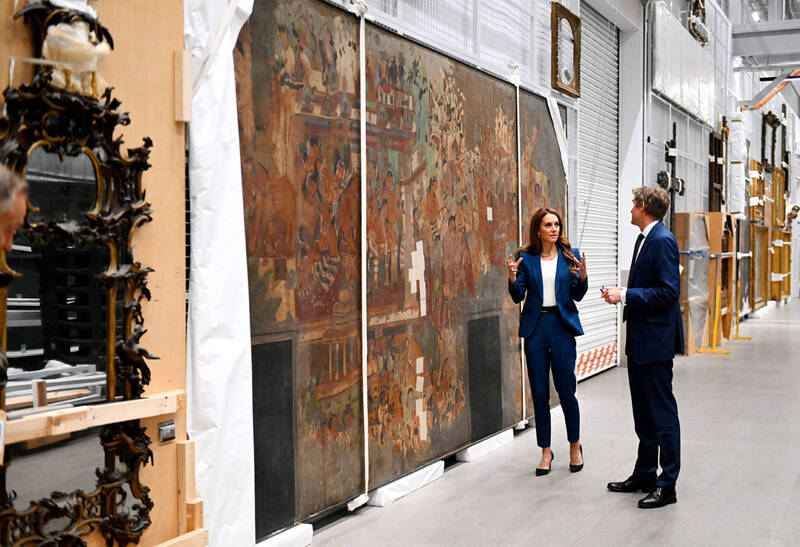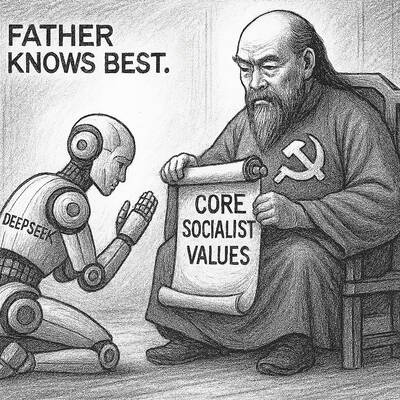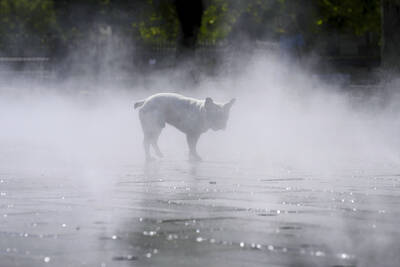Imagine being able to visit a museum and examine up close thousand-year-old pottery, revel alone in jewelry from centuries past, or peer inside a Versace bag.
Now London’s V&A has launched a revolutionary new exhibition space, where visitors can choose from some 250,000 objects, order something they want to spend time looking at and have it delivered to a room for a private viewing.
Most museums have thousands of precious and historic items hidden away in their stores, which the public never gets to see or enjoy.

Photo: AFP
But the V&A Storehouse, which opened on May 31 in a converted warehouse, has come up with a radical new concept. And it is totally free.
“Museums should be and are for everybody ... the V&A’s collection is for everybody. It belongs to everybody, and everyone should be able to have free, equitable, and meaningful access to it,” said senior curator Georgia Haseldine.
“So this is a world first, never has anyone been able to be invited freely, without having to book into the same space as a national collection, on this scale.”
One fifth of the museum’s total collection is now available to be viewed and enjoyed in the four-story building on the former site of the 2012 London Olympic Games.
NO PROTECTIVE GLASS
“It’s fantastic, it’s so much better than an ordinary museum,” enthused retired physics teacher Jane Bailey as she toured the floors.
“I’m just really, really impressed by it. We’ve only just heard about it, but it’s phenomenal.”
She was transfixed by the sight of the black and red drum kit which belonged to Keith Moon, from the band The Who, saying it would be great to be able to resuscitate the legendary drummer who died in 1978, to play a set for them.
Jostling for space, side-by-side on shelves in a massive hanger which resembles a DIY commercial warehouse and stretches for more than 30 basketball courts, are everything from ceramics and tapestries, to paintings and toys from the Tudor period.
There is even the whole 15th-century gilded wooden ceiling from the now-lost Torrijos Palace, and the Kaufmann Office, a paneled room which is the only complete Frank Lloyd Wright interior outside of the US.
Hanging on display is the stunning stage front cloth made for Le Train Bleu — a copy of a Pablo Picasso painting it was designed for the 1924 Ballets Russes production. At 12 meters, its huge size means it has rarely been seen since its stage debut.
There is no protective glass.
One of the first visitors to the Storehouse was Princess Catherine, a patron of the V&A and keen art lover, who took a tour on Tuesday.
She described the collection as “eclectic” as she used the “order an object” system to look at a samples book from renowned 19th century English textiles designer William Morris as well as rolls of ornate textiles and a musical instrument.
All the works are available to the public seven days a week, and can be reserved via an online booking system for a private viewing at a date and time of your choice.
Members of staff are on hand paying close attention as visitors don purple gloves and satisfy their curiosity, spending time with the object of their choice.
‘LOVE LETTER’
It’s a huge departure from the usual admonishment of “Don’t touch!” found in most museums seeking to protect their objects from damage.
Curator Haseldine acknowledged “we have certainly met with some levels of skepticism and worry.”
But she said once the idea was explained properly including “how meaningful it is to ... start to open up and give collections back to a community ...people just start to think creatively about how we can do this.”
American national Manuel Garza living in London said he thought the V&A Storehouse was “one of the most interesting spaces that just opened up here in London.”
Haseldine said “this building is a love letter to objects.”
“To be able to see around the back of an object, to be able to look inside a dress, to be able to see the bottom of a pot, all these things are how we really learn about our material culture,” she added.
Expert Kate Hill, who teaches cultural history at Lincoln University, said “it’s pretty unusual for museums to open up their storehouses.”
“Most of the time they offer some ‘behind the scene’ tour, but their objects are not accessible. It’s visible but not accessible.”
Visitor Jane Bailey said: “I would hope that this is the museum of the future, because some are very, very stuffy. We went to one recently and it was excruciating.”

Has the Taiwan People’s Party (TPP) changed under the leadership of Huang Kuo-chang (黃國昌)? In tone and messaging, it obviously has, but this is largely driven by events over the past year. How much is surface noise, and how much is substance? How differently party founder Ko Wen-je (柯文哲) would have handled these events is impossible to determine because the biggest event was Ko’s own arrest on multiple corruption charges and being jailed incommunicado. To understand the similarities and differences that may be evolving in the Huang era, we must first understand Ko’s TPP. ELECTORAL STRATEGY The party’s strategy under Ko was

It’s Aug. 8, Father’s Day in Taiwan. I asked a Chinese chatbot a simple question: “How is Father’s Day celebrated in Taiwan and China?” The answer was as ideological as it was unexpected. The AI said Taiwan is “a region” (地區) and “a province of China” (中國的省份). It then adopted the collective pronoun “we” to praise the holiday in the voice of the “Chinese government,” saying Father’s Day aligns with “core socialist values” of the “Chinese nation.” The chatbot was DeepSeek, the fastest growing app ever to reach 100 million users (in seven days!) and one of the world’s most advanced and

It turns out many Americans aren’t great at identifying which personal decisions contribute most to climate change. A study recently published by the National Academy of Sciences found that when asked to rank actions, such as swapping a car that uses gasoline for an electric one, carpooling or reducing food waste, participants weren’t very accurate when assessing how much those actions contributed to climate change, which is caused mostly by the release of greenhouse gases that happen when fuels like gasoline, oil and coal are burned. “People over-assign impact to actually pretty low-impact actions such as recycling, and underestimate the actual carbon

An internal Meta Platforms document detailing policies on chatbot behavior has permitted the company’s artificial intelligence creations to “engage a child in conversations that are romantic or sensual,” generate false medical information and help users argue that Black people are “dumber than white people.” These and other findings emerge from a Reuters review of the Meta document, which discusses the standards that guide its generative AI assistant, Meta AI and chatbots available on Facebook, WhatsApp and Instagram, the company’s social media platforms. Meta confirmed the document’s authenticity, but said that after receiving questions earlier this month, the company removed portions which stated